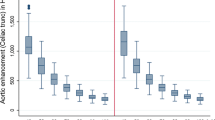Abstract
Object
A three-dimensional (3D) visualization of the target region during intravascular interventions in real-time is challenging since the acquisition of a time-consuming 3D dataset is required. In this work, a novel stereoscopic double echo sequence for achieving 3D depth perception by sampling only two oblique projection images is presented.
Materials and methods
A double echo (DE) FLASH pulse sequence was developed to acquire continuously stereoscopic image pairs of the vascular target anatomy. Stereo image data were displayed on a stereoscopic 3D LCD monitor in real time after image reconstruction. Phantom experiments followed by a depth perception test were performed to assess the usability of the stereo image pairs for 3D visualization. In an animal experiment the sequence was tested in vivo and was compared with a slower interleaved (IL) sequence variant.
Results
In the phantom experiments an SNR difference of 6 % between left and right image was found which did not influence the depth perception. The DE acquisition was superior to the IL sequence (SNRDE = 10.3, 2.3 images/s over SNRIL = 7.1, 1.7 images/s), and during contrast enhancement the abdominal arterial vasculature was clearly perceived as a 3D structure.
Conclusion
A novel stereoscopic DE pulse sequence can be utilized for the fast 3D stereoscopic visualization of vascular structures in real-time.






Similar content being viewed by others
References
Bock M, Umathum R, Zuehlsdorff S, Volz S, Fink C, Hallscheidt P, Zimmermann H, Nitz W, Semmler W (2005) Interventional magnetic resonance imaging: an alternative to image guidance with ionising radiation. Radiat Prot Dosimetry 117(1–3):74–78
Wentz KU, Mattle HP, Edelman RR, Kleefield J, O’Reilly GV, Liu C, Zhao B (1991) Stereoscopic display of MR angiograms. Neuroradiology 33(2):123–125
Hernes TA, Ommedal S, Lie T, Lindseth F, Lango T, Unsgaard G (2003) Stereoscopic navigation-controlled display of preoperative MRI and intraoperative 3D ultrasound in planning and guidance of neurosurgery: new technology for minimally invasive image-guided surgery approaches. Minim Invasive Neurosurg 46(3):129–137
Peters TM, Henri CJ, Munger P, Takahashi AM, Evans AC, Davey B, Olivier A (1994) Integration of stereoscopic DSA and 3D MRI for image-guided neurosurgery. Comput Med Imaging Graph 18(4):289–299
Moseley ME, White DL, Wang SC, Wikstrom M, Gobbel G, Roth K (1989) Stereoscopic MR imaging. J Comput Assist Tomogr 13(1):167–173
Guttman MA, Epstein FH, McVeigh ER (2003) Fast stereoscopic MRI for clinical procedures. In: Proceedings of the 8th scientific meeting, international society for magnetic resonance in medicine, Denver, p 67
Guttman MA, McVeigh ER (2001) Techniques for fast stereoscopic MRI. Magn Reson Med 46(2):317–323
Kumamoto E (2002) Three-dimensional visualization of catheter using stereoscopic MR images. In: Proceedings of the 10th scientific meeting, international society for magnetic resonance in medicine, Honolulu, p 2273
Chen CN (1998) Generation of depth-perception information in stereoscopic nuclear magnetic resonance imaging by non-linear magnetic field gradients. Magn Reson Med 16(4):405–412
Kumamoto E, Ono K, Saito K, Matsuoka Y, Keserci B, Abe H, Kuroda K, Matsui Y, Mitsuhasi H, Fujii S (2004) marking technique for ″bamboo″ tracking catheter in MR guided intervention. In: Proceedings of the 12th annual meeting of ISMRM, Kyoto, p 498
Maier F, Krafft AJ, Jenne JW, Semmler W, Bock M (2009) TAM—a thermal ablation monitoring tool: in vivo evaluation. In: World congress on medical physics and biomedical engineering, Munich, pp 247–250
Gregory CD, Potter CS, Lauterbur PC (1988) Interactive stereoscopic MRI with the NmrScope. In: Proceedings of the 4th scientific meeting, international society for magnetic resonance in medicine, New York, p 1601
Cho Z, Kim D, Kim Y (1988) Total inhomogeneity correction including chemical shifts and susceptibility by view angle tilting. Med phy 15(1):7–11
Gould G (1910) A method of determining ocular dominance. JAMA 55:369–370
USAEyes (2010) Dominant eye test card. Retrieved 03 Feb 2012, from http://www.usaeyes.org/lasik/library/Dominant-Eye-Test.pdf
Guttman MA, Kellman P, Dick AJ, Lederman RJ, McVeigh ER (2003) Real-time accelerated interactive MRI with adaptive TSENSE and UNFOLD. Magn Reson Med 50(2):315–321
Julesz B (1964) Binocular depth perception without familiarity cues. Science 145(3630):356–362
Bernstein MA, King KE, Zhou XJ, Fong W (2005) Handbook of MRI pulse sequences. Elsevier Academic Press, Burlington
Muller S, Umathum R, Speier P, Zuhlsdorff S, Ley S, Semmler W, Bock M (2006) Dynamic coil selection for real-time imaging in interventional MRI. Magn Reson Med 56(5):1156–1162
Bock M, Muller S, Zuehlsdorff S, Speier P, Fink C, Hallscheidt P, Umathum R, Semmler W (2006) Active catheter tracking using parallel MRI and real-time image reconstruction. Magn Reson Med 55(6):1454–1459
Acknowledgments
The authors thank Dr. Ann-Kathrin Homagk, Dr. Lars Gerigk, Dr. Martin Freitag, Roland Galmbacher, Barbara Dillenberger, and Moritz Berger (Medical Physics in Radiology, German Cancer Research Center, Heidelberg, Germany) for their help with phantom/animal experiments and wish to acknowledge grant support from the Deutsche Forschungsgemeinschaft (DFG) under grant number BO3025/2-1.
Author information
Authors and Affiliations
Corresponding author
Electronic supplementary material
Below is the link to the electronic supplementary material.
Rights and permissions
About this article
Cite this article
Brunner, A., Maier, F., Krafft, A.J. et al. Two eyes see more than one: double echo stereoscopic MRA for rapid 3D visualization of vascular structures. Magn Reson Mater Phy 25, 411–418 (2012). https://doi.org/10.1007/s10334-012-0313-z
Received:
Revised:
Accepted:
Published:
Issue Date:
DOI: https://doi.org/10.1007/s10334-012-0313-z




